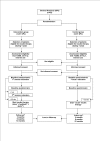Web-based guided insulin self-titration in patients with type 2 diabetes: the Di@log study. Design of a cluster randomised controlled trial [TC1316]
- PMID: 19508712
- PMCID: PMC2703619
- DOI: 10.1186/1471-2296-10-40
Web-based guided insulin self-titration in patients with type 2 diabetes: the Di@log study. Design of a cluster randomised controlled trial [TC1316]
Abstract
Background: Many patients with type 2 diabetes (T2DM) are not able to reach the glycaemic target level of HbA1c < 7.0%, and therefore are at increased risk of developing severe complications. Transition to insulin therapy is one of the obstacles in diabetes management, because of barriers of both patient and health care providers. Patient empowerment, a patient-centred approach, is vital for improving diabetes management. We developed a web-based self-management programme for insulin titration in T2DM patients. The aim of our study is to investigate if this internet programme helps to improve glycaemic control more effectively than usual care.
Methods/design: T2DM patients (n = 248), aged 35-75 years, with an HbA1c > or = 7.0%, eligible for treatment with insulin and able to use the internet will be selected from general practices in two different regions in the Netherlands. Cluster randomisation will be performed at the level of general practices. Patients in the intervention group will use a self-developed internet programme to assist them in self-titrating insulin. The control group will receive usual care.Primary outcome is the difference in change in HbA1c between intervention and control group. Secondary outcome measures are quality of life, treatment satisfaction, diabetes self-efficacy and frequency of hypoglycaemic episodes. Results will be analysed according to the intention-to-treat principle.
Discussion: An internet intervention supporting self-titration of insulin therapy in T2DM patients is an innovative patient-centred intervention. The programme provides guided self-monitoring and evaluation of health and self-care behaviours through tailored feedback on input of glucose values. This is expected to result in a better performance of self-titration of insulin and consequently in the improvement of glycaemic control. The patient will be enabled to 'discover and use his or her own ability to gain mastery over his/her diabetes' and therefore patient empowerment will increase. Based on the self-regulation theory of Leventhal, we hypothesize that additional benefits will be achieved in terms of increases in treatment satisfaction, quality of life and self-efficacy.
Trial registration: Dutch Trial Register TC1316.
Figures

Similar articles
-
Effectiveness of diabetes self-management education via a smartphone application in insulin treated type 2 diabetes patients - design of a randomised controlled trial ('TRIGGER study').BMC Endocr Disord. 2018 Oct 22;18(1):74. doi: 10.1186/s12902-018-0304-9. BMC Endocr Disord. 2018. PMID: 30348142 Free PMC article. Clinical Trial.
-
An exploratory trial of basal and prandial insulin initiation and titration for type 2 diabetes in primary care with adjunct retrospective continuous glucose monitoring: INITIATION study.Diabetes Res Clin Pract. 2014 Nov;106(2):247-55. doi: 10.1016/j.diabres.2014.08.011. Epub 2014 Sep 8. Diabetes Res Clin Pract. 2014. PMID: 25271117 Clinical Trial.
-
BetaMe: impact of a comprehensive digital health programme on HbA1c and weight at 12 months for people with diabetes and pre-diabetes: study protocol for a randomised controlled trial.Trials. 2018 Mar 5;19(1):161. doi: 10.1186/s13063-018-2528-4. Trials. 2018. PMID: 29506562 Free PMC article.
-
Self-titration of insulin in the management of people with type 2 diabetes: a practical solution to improve management in primary care.Diabetes Obes Metab. 2013 Aug;15(8):690-700. doi: 10.1111/dom.12053. Epub 2013 Jan 29. Diabetes Obes Metab. 2013. PMID: 23253563 Review.
-
Insulin during pregnancy, labour and delivery.Best Pract Res Clin Obstet Gynaecol. 2011 Feb;25(1):65-76. doi: 10.1016/j.bpobgyn.2010.10.002. Epub 2010 Dec 24. Best Pract Res Clin Obstet Gynaecol. 2011. PMID: 21186142 Review.
Cited by
-
The patient as a prosumer of healthcare: insights from a bibliometric-interpretive review.J Health Organ Manag. 2022 Apr 5;36(9):133-157. doi: 10.1108/JHOM-11-2021-0401. J Health Organ Manag. 2022. PMID: 35383429 Free PMC article.
-
Impact of Nurse-Led Titration Versus Physician Prescription of Hypoglycaemic Agents on HbA1c Level in Type 2 Diabetes Patients: A Systematic Review and Meta-Analysis of Randomized Controlled Trials.Cureus. 2021 Dec 15;13(12):e20436. doi: 10.7759/cureus.20436. eCollection 2021 Dec. Cureus. 2021. PMID: 35047273 Free PMC article. Review.
-
Effects of lifestyle education program for type 2 diabetes patients in clinics: study design of a cluster randomized trial.BMC Public Health. 2010 Nov 30;10:742. doi: 10.1186/1471-2458-10-742. BMC Public Health. 2010. PMID: 21118514 Free PMC article. Clinical Trial.
-
Diabetes self-management arrangements in Europe: a realist review to facilitate a project implemented in six countries.BMC Health Serv Res. 2014 Oct 2;14:453. doi: 10.1186/1472-6963-14-453. BMC Health Serv Res. 2014. PMID: 25278037 Free PMC article. Review.
References
-
- Standards of medical care in diabetes – 2008. Diabetes Care. 2008;31:S12–S54. - PubMed
-
- Bouma M, Rutten GE, de Grauw WJ, Wiersma T, Goudswaard AN. [Summary of the practice guideline 'Diabetes mellitus type 2' (second revision) from the Dutch College of General Practitioners] Ned TijdschrGeneeskd. 2006;150:2251–2256. - PubMed
-
- Nathan DM, Buse JB, Davidson MB, Ferrannini E, Holman RR, Sherwin R, Zinman B. Medical management of hyperglycaemia in type 2 diabetes mellitus: a consensus algorithm for the initiation and adjustment of therapy: A consensus statement from the American Diabetes Association and the European Association for the Study of Diabetes. Diabetes Care. 2009;32:193–203. doi: 10.2337/dc08-9025. - DOI - PMC - PubMed
Publication types
MeSH terms
Substances
LinkOut - more resources
Full Text Sources
Medical

